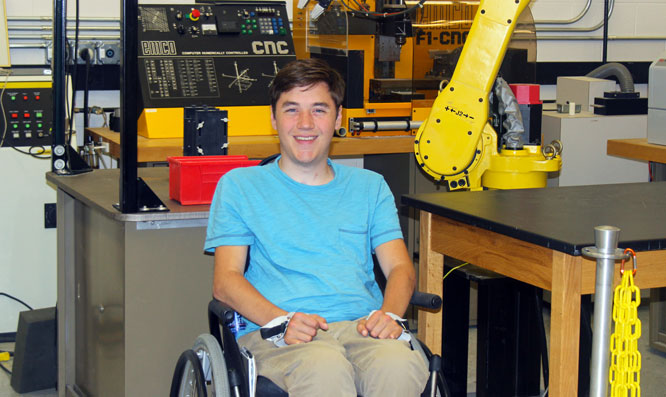By Eric Reikowski, media relations assistant
For John Katona, engineering is more of a calling than a career. The master's student in Oakland University's Industrial and Systems Engineering (ISE) program wants to use his education to tackle challenges and improve lives.
The 25-year-old brings a unique outlook, having overcome his own set of trials. While in high school, Katona was involved in a car accident that left him paralyzed from the chest down. He underwent months of rehab and had to relearn how to perform everyday tasks. In the process, he discovered that his most powerful tool was his mind.
“I realized that I could use my mind to do something valuable,” Katona said. “It became even more important for me to go to college and succeed as an engineer.”
Katona started working toward his goal by enrolling in the engineering program at OU. Initially an electrical engineering major, he switched to industrial and systems engineering after taking an introductory lab course with Dr. Robert Van Til, professor and chair of the ISE department.
“All the concepts made sense,” Katona recalled. “I really enjoyed the lab, and I knew this would be a good fit. My undergraduate years gave me a strong foundation to build upon.”
As he was finishing his bachelor's degree, Katona was offered the chance to be a teaching assistant and pursue a master's degree in industrial and systems engineering. He decided to put his job search plans on hold and is now teaching undergraduate students how to use simulation software to design and analyze a variety of systems, including those found in automobile plants, banks and hospitals.
“Designing in the digital domain, rather than building physical prototypes, saves businesses both time and money, which allows them to be competitive in the global economy,” Dr. Van Til explained. “The ISE department has been working to integrate these tools into our programs to educate the engineers of the future.”
All Oakland engineering students are required to complete a senior design project to demonstrate hands-on understanding of engineering principles. For his project, Katona teamed with two OU ISE students, a professional engineer and a team of clinicians to streamline radiology processes at the Crittenton Hospital Medical Center. By redesigning the system, the project helped reduce the time for patients to receive certain medical tests.
“John not only showed his ability as an engineer on this project,” Dr. Van Til noted, “but he also demonstrated strong leadership skills.”
Katona said that while he may eventually pursue a Ph.D., first he wants to gain more experience working in industry.
“To be a good engineer, you need to spend a lot of time working on real-world problems,” he said. “The greatest lessons of engineering are learned in the field.”
Between studying and teaching, Katona also finds time to mentor elementary and high school students. He is a student leader for OU engineering camps, which introduce area students to basic topics such as Lean principles, robots, motors and circuits. One recent activity involved setting up an assembly line to build paper airplanes. The students were tasked with designing an efficient process that included everything from procuring materials, building the planes and presenting the finished product.
“I love to see young people get excited about engineering,” Katona said. “The field is always growing and evolving and there's a high demand for engineering talent. Reaching out to these kids helps prepare them for the future.”
Oakland University is a vibrant academic community with nearly 20,000 students and more than 260 degree and certificate programs. To learn more about academics, achievements, and events at OU, visit the news site at
oakland.edu/newsatou and follow the news team on Twitter at
@OaklandU_News.

